Best laptops for Rhino 3D | Rhino 3D is a powerful NURBS modeling software used for a variety of applications, from jewelry design to architectural visualization. But with its demanding processing needs, not just any laptop can handle it. To ensure smooth performance and efficient workflows, you’ll need a machine that packs a punch.
In this blog post, we’ll be taking a look at the best laptops for Rhino 3D in 2024. We’ll consider factors like processor, graphics card, RAM, storage, and display, to help you find the perfect laptop for your needs and budget.
Whether you’re a seasoned Rhino pro or just starting out, we’ve got you covered. So, buckle up and get ready to find your dream Rhino machine!

Rhino laptop requirements
- Processor: 64-bit Intel or AMD processor (not ARM)
- RAM: 8GB (16GB or more is recommended)
- Disk space: 5GB
- Operating system: Windows 10/11 or macOS
- Graphics card: OpenGL 4.1 capable video card with at least 4GB of video RAM
Best laptops for Rhino 3D
- Apple MacBook Pro Laptop M3 Pro chip ($2,115)
- ASUS Creator Laptop Q530 ($1,159)
- Dell XPS 15 9530 Business Laptop ($1,899)
- HP Victus 15 Gaming Laptop ($633)
- Lenovo Slim7 Touchscreen Laptop ($1,379)
- Acer Swift X Intel Evo Thin & Light Creator Laptop ($929)
1. Apple MacBook Pro Laptop M3 Pro chip
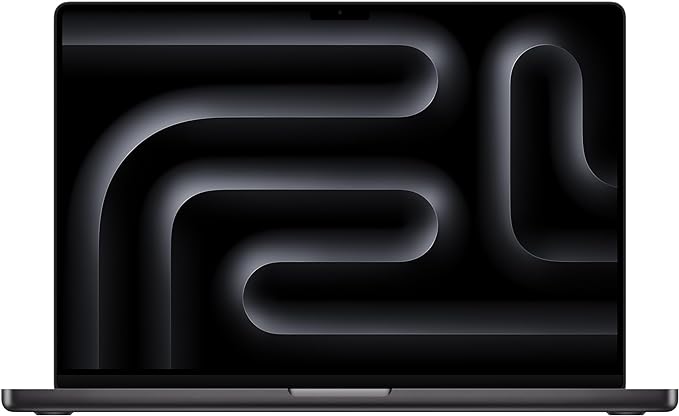
| Model Name | MacBook Pro |
| Screen Size | 16.2 Inches |
| Hard Disk Size | 512 GB |
| Ram Memory Installed Size | 18 GB |
| Operating System | Mac OS |
| Graphics Coprocessor | Apple Integrated Graphics |
The MacBook Pro with the M3 Pro or M3 Max chip is an excellent choice for Rhino, a 3D modeling software, for several reasons:
Properties of MacBook Pro
- Powerful Performance: The M3 Pro chip with a 12-core CPU and 18-core GPU, or the M3 Max with an up to 16-core CPU and up to 40-core GPU, ensures exceptional performance. This is crucial for handling complex 3D models and rendering intricate designs in Rhino.
- Optimized for Demanding Workflows: The advanced capabilities of the M3 Pro and M3 Max chips make the MacBook Pro suitable for demanding workflows, such as rendering 3D content or developing models with millions of parameters, which are common tasks in Rhino.
- Impressive Display: The 16.2-inch Liquid Retina XDR display with Extreme Dynamic Range and high brightness levels provides an excellent visual experience. This is beneficial for accurately viewing and editing detailed 3D models in Rhino, enhancing overall productivity.
- Compatibility with Professional Apps: The MacBook Pro ensures seamless performance with professional applications like Rhino, thanks to its compatibility with pro apps, including 3D modeling software like Rhino, Adobe Creative Cloud, and others essential for design and development.
- Ample Connectivity: The MacBook Pro offers versatile connectivity options, including Thunderbolt 4 ports and HDMI, which can be crucial for connecting external displays or other peripherals while working with Rhino.
- Long Battery Life: With up to 22 hours of battery life, the MacBook Pro allows users to work on Rhino projects for extended periods without worrying about running out of power. This is especially useful for professionals who need to work on-the-go or in environments without readily available power sources.
- Advanced Camera and Audio: The 1080p FaceTime HD camera and studio-quality three-mic array are beneficial for virtual collaboration and communication, ensuring that your work in Rhino can be shared seamlessly with others.
- Magic Keyboard with Touch ID: The backlit Magic Keyboard with Touch ID provides a secure and convenient way to access the laptop, enhancing overall user experience when working on Rhino projects.
- Built to Last: The durable all-aluminum unibody enclosure ensures the longevity of the MacBook Pro, making it a reliable choice for professionals working with Rhino over an extended period.
- Cross-Device Integration: The MacBook Pro seamlessly integrates with other Apple devices, allowing for a smooth workflow across devices. This can be advantageous when transferring files or working collaboratively with Rhino projects on different Apple products.
In summary, the MacBook Pro with M3 Pro or M3 Max chips offers a powerful, versatile, and reliable solution for professionals using Rhino, combining top-tier performance, an exceptional display, and a range of features optimized for demanding 3D modeling workflows.
2. Creator Q530 (Best ASUS laptop for Rhino 3D)
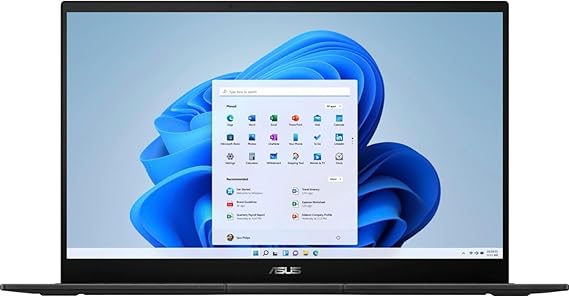
| Model Name | Creator Laptop Q |
| Screen Size | 15.6 Inches |
| Color | Black |
| Hard Disk Size | 1 TB |
| CPU Model | Core i7 Family |
| Ram Memory Installed Size | 16 GB |
| Operating System | Windows 11 Home |
| Graphics Card Description | NVIDIA GeForce RTX 3050 6GB Dedicated |
The ASUS Creator Laptop Q, as described, appears to be a solid choice for Rhino, a 3D modeling software commonly used in design and architecture. Here are some reasons why this laptop could be a good choice:
Properties of Creator Q
- Powerful Processor: The 13th Generation Intel Core i7-13620H 10-Core processor with a base clock of 2.9GHz (up to 5.0 GHz with Turbo Boost) and 16 threads provides ample power for running resource-intensive applications like Rhino, which can benefit from a high-performance CPU.
- Ample RAM and Storage: The upgraded 16GB DDR5 SDRAM at 4800 MHz and a 1TB NVMe M.2 Solid State Drive provide fast and efficient memory and storage, enabling smooth multitasking and quick access to large design files.
- Graphics Performance: The NVIDIA GeForce RTX 3050 with 6GB GDDR6 is a capable GPU that can handle graphics-intensive tasks. This is crucial for rendering and visualizing complex 3D models in Rhino.
- High-Quality Display: The 15.6″ FHD OLED Display with 600 nits brightness, 100% DCI-P3 color gamut, and 1 ms response time, along with features like Dolby Vision, makes it suitable for detailed and color-accurate work in design applications.
- Connectivity Options: The laptop offers a variety of ports, including Thunderbolt 4/USB4 and USB 3.2 Gen 2 Type-C, providing high-speed data transfer capabilities. This is essential for connecting external devices and peripherals commonly used in design work.
- Portability: With a 180-degree hinge design, a relatively lightweight design at 3.97 lbs, and a 90Whr 3-cell lithium-ion battery, the laptop is reasonably portable, allowing designers to work on their projects on the go.
- Keyboard and Input Features: The full-size backlit keyboard with a fingerprint reader and Numpad provides convenience, and the 3DNR FHD webcam with Privacy Shutter is a plus for video conferences or virtual collaboration.
- Operating System: The inclusion of Windows 11 Home ensures compatibility with the latest software and updates, enhancing the overall user experience.
Considering these features, the ASUS Creator Laptop Q seems to offer a well-rounded package that aligns with the requirements of running Rhino efficiently, making it a potentially excellent choice for professionals in design and architecture.
3. XPS 15 9530 (Best Dell laptop for Rhino 3D)
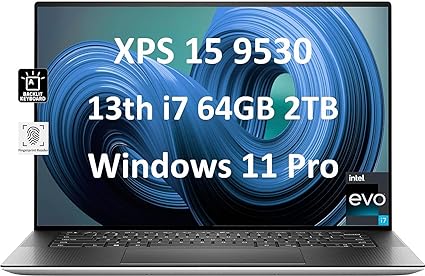
| Model Name | DELL XPS 15 9530 |
| Screen Size | 15.6 Inches |
| Color | Silver |
| Hard Disk Size | 2 TB |
| CPU Model | Core i7 |
| Ram Memory Installed Size | 64 GB |
| Operating System | Windows 11 Pro |
| Graphics Card Description | Intel Arc A370M Dedicated |
The Dell XPS 15 9530 Business Laptop, with its impressive specifications, is a solid choice for professionals working with Rhino, a 3D modeling software widely used in design and engineering fields. Here are specific features that make it a suitable option:
Properties of XPS 15 9530
- High-Performance Configuration: The laptop boasts a powerful Intel Core i7-13700H Evo processor with 14 cores and 16 threads, providing robust processing capabilities. The 64GB DDR5 4800MHz RAM ensures smooth multitasking and efficient handling of complex 3D models in Rhino.
- Graphics Capability: The dedicated Intel Arc A370M GPU with 4GB GDDR6 VRAM is well-suited for 3D modeling tasks. The ability to expand to 4 monitors via Thunderbolt 4 allows for a versatile multi-display setup, enhancing the workflow for Rhino users who often benefit from extended screen real estate.
- High-Resolution Display: The 15.6-inch FHD+ InfinityEdge display with a 16:10 aspect ratio and 100% Adobe RGB coverage provides a visually immersive experience. The anti-glare IPS panel with 500 nits brightness ensures accurate color representation, crucial for design work in Rhino.
- Storage and Memory Capacity: The 2TB PCIe SSD offers ample and fast storage for large Rhino project files, contributing to quick load times and seamless data access. The upgraded 64GB RAM provides a substantial memory buffer for handling resource-intensive tasks.
- Connectivity Options: The laptop features Thunderbolt 4 and USB 3.2 Gen 2 Type-C ports, providing high-speed data transfer capabilities, essential for handling large design files. The ability to connect to 4K external monitors at 60Hz is beneficial for visualizing intricate details in Rhino models.
- Durability and Security: The inclusion of a backlit keyboard, fingerprint reader, and a three-year warranty on upgraded memory and SSD add to the overall user experience. These features contribute to a reliable and secure computing environment for professionals relying on Rhino for their design work.
- Windows 11 Pro: The laptop comes with Windows 11 Pro 64-bit, offering a secure and efficient operating system that complements the hardware capabilities, providing a stable platform for Rhino and other design software.
In summary, the Dell XPS 15 9530 with its powerful specifications, high-quality display, extensive connectivity options, and durability is well-suited for professionals working with Rhino, offering an excellent balance of performance and reliability for design and 3D modeling tasks.
4. HP Victus 15 (Best laptop for Rhino 3D gaming)
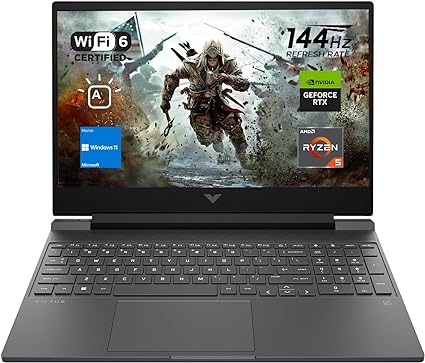
| Model Name | TPN-Q279_598U1AV |
| Screen Size | 15.6 Inches |
| Color | Silver |
| Hard Disk Size | 1 TB |
| CPU Model | Ryzen 5 |
| Ram Memory Installed Size | 16 GB |
| Operating System | Windows 11 Home |
| Special Feature | Backlit Keyboard |
| Graphics Card Description | NVIDIA GeForce RTX 2050 Dedicated |
The HP Victus 15, with its robust specifications, makes for an excellent choice for Rhino 3D users for several reasons:
Properties of Victus 15
- Powerful AMD Ryzen Processor: The AMD Ryzen 5 7535HS processor with its 6 cores and 12 threads, along with a base clock of 3.3 GHz and a boost clock of up to 4.55 GHz, provides ample processing power for handling complex 3D modeling tasks in Rhino 3D with ease.
- High-bandwidth DDR5 RAM: The 16GB of high-bandwidth DDR5 RAM ensures smooth multitasking capabilities, allowing users to run Rhino 3D alongside other applications without experiencing any slowdowns or lags.
- Fast Storage: The 1TB PCIe M.2 Solid State Drive offers fast boot-up times and speedy data transfer rates, which are crucial for opening large Rhino 3D files quickly and accessing project assets without delays.
- Dedicated Graphics Card: The NVIDIA GeForce RTX 2050 with 4GB of GDDR6 memory provides sufficient graphical horsepower for rendering and visualizing 3D models in Rhino 3D, ensuring a smooth and immersive user experience.
- High Refresh Rate Display: The 15.6″ FHD display with a 144Hz refresh rate ensures smooth and fluid visuals, which is beneficial for viewing intricate 3D models in Rhino 3D with precision and clarity.
- Connectivity Options: The laptop offers a range of connectivity options including USB Type-A, USB Type-C, HDMI 2.1, and RJ-45 ports, allowing users to easily connect external peripherals such as drawing tablets, external monitors, and network devices for enhanced productivity.
- Windows 11 Home: The pre-installed Windows 11 Home operating system provides a modern and intuitive user interface, along with enhanced multi-monitor functionality, which can improve workflow efficiency for Rhino 3D users who often work with multiple windows and monitors simultaneously.
Overall, the HP Victus 15 offers a balanced combination of processing power, graphics performance, storage capacity, and connectivity options, making it an excellent choice for professionals and enthusiasts looking for a capable laptop for Rhino 3D modeling and design tasks.
5. Slim7 (Best Lenovo laptop for Rhino 3D)
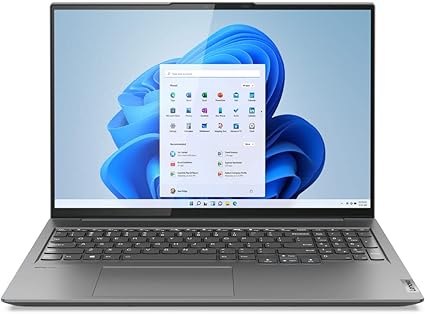
| Model Name | Slim 7 |
| Screen Size | 16 Inches |
| Color | Storm Grey |
| Hard Disk Size | 1 TB |
| CPU Model | Core i7 Family |
| Ram Memory Installed Size | 32 GB |
| Operating System | Windows 11 Pro |
| Special Feature | HD Audio, Backlit Keyboard, Memory Card Slot, Numeric Keypad |
| Graphics Card Description | Intel Arc A370M Dedicated |
The Lenovo Slim7 with the specified features is an excellent choice for Rhino 3D for several reasons:
Properties of Lenovo Slim
- Powerful Processor: The 12th Generation Intel Core i7-12700H 14-Core Processor with up to 4.7 GHz clock speed and 24 MB Intel Smart cache provides significant processing power. Rhino 3D can benefit from the high core count and clock speed for smooth modeling and rendering.
- Ample Memory: The upgrade to 32GB DDR5 SDRAM at 4800 MHz ensures smooth multitasking and handling of large datasets in Rhino 3D.
- Fast Storage: The 1TB PCI-E NVMe Solid State Drive offers fast read/write speeds, which is crucial for loading large Rhino 3D files quickly and for smooth operation.
- High-Resolution Touchscreen Display: The 16″ WQXGA IPS touchscreen with a resolution of 2560 x 1600 and 500 nits brightness provides a vibrant and detailed viewing experience. This is essential for accurately visualizing designs and working on intricate details in Rhino 3D.
- Graphics Performance: The Intel Arc A370M Graphics, while not as specialized as dedicated workstation GPUs, still offers solid graphics performance for 3D modeling tasks in Rhino 3D.
- Connectivity Options: The laptop offers a variety of ports including Thunderbolt 4, USB 3.2 Gen 1, HDMI 2.0, and headphone/microphone combo jack, ensuring seamless connectivity with external devices such as monitors and peripherals commonly used in Rhino 3D workflows.
- Comfortable Input: The full-size backlit keyboard with a numpad provides comfortable typing experience even in low-light conditions, which is helpful for extended work sessions.
- Portability and Battery Life: Despite its powerful specifications, the laptop remains relatively lightweight at 4.59 lbs and offers up to 10 hours of battery life. This makes it suitable for on-the-go use, allowing users to work on Rhino 3D projects without being tethered to a power outlet for extended periods.
Overall, the Lenovo Slim7 with its powerful hardware, high-resolution display, and extensive connectivity options offers a compelling package for professionals working with Rhino 3D, making it one of the best laptops for this purpose.
6. Acer Swift X Intel Evo Thin & Light Creator Laptop
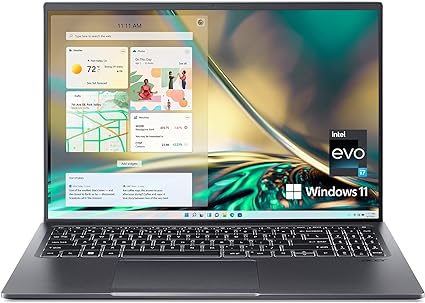
| Model Name | SFX16-52G-73U6 |
| Screen Size | 16 |
| Color | Gray |
| Hard Disk Size | 512 GB |
| CPU Model | Core i7 |
| Ram Memory Installed Size | 16 GB |
| Operating System | Windows 11 Home |
| Special Feature | Intel Arc A370M, Killer Wireless Wi-Fi 6E AX1675, Fingerprint Reader |
| Graphics Card Description | Dedicated |
The Acer Swift X Intel Evo Thin & Light Creator Laptop is a compelling choice for running Rhino 3D, a sophisticated 3D modeling software, for several reasons:
Properties of Acer Swift X
- High-Performance Processor: The Intel Core i7-1260P Processor, with its 12 cores and 16 threads, and a maximum clock speed of up to 4.7GHz, ensures that complex 3D modeling tasks in Rhino can be handled smoothly. Rhino 3D benefits from high single-core performance, and this processor’s architecture provides both the speed and multitasking capabilities needed for demanding applications.
- Dedicated Graphics Card: The Intel Arc A370M with 4GB GDDR6 is a dedicated GPU that significantly enhances the laptop’s ability to render 3D models and handle graphical computations. Rhino 3D, while primarily CPU-intensive, can take advantage of a dedicated GPU for rendering and handling complex geometries efficiently.
- High-Resolution Display: The 16.0″ WUXGA (1920 x 1200) IPS LED-backlit display with 100% sRGB coverage and 400 nits brightness provides excellent color accuracy and brightness. This is essential for detailed 3D modeling work, ensuring that you can see your designs clearly and accurately.
- Adequate Memory and Storage: With 16GB of LPDDR4x memory, the laptop is well-equipped to handle large Rhino 3D files and multiple applications running simultaneously. The 512GB PCIe Gen 4 SSD provides fast read/write speeds, reducing load times and improving overall system responsiveness, which is crucial when working with large 3D models.
- Advanced Connectivity Options: The inclusion of USB4, Thunderbolt 4, and HDMI 2.1 ports allows for high-speed data transfer and connectivity to external displays and peripherals. This is particularly useful for expanding your workspace with additional monitors or connecting external GPUs for even more graphical power.
- Enhanced User Experience Features: Features like the back-lit keyboard, fingerprint reader, OceanGlass touchpad, and a high-quality FHD webcam add to the convenience and security of using the laptop. The inclusion of Wi-Fi 6E ensures faster and more reliable internet connectivity, which is beneficial for downloading large files or collaborating online.
- Portability and Battery Life: Despite its powerful hardware, the laptop remains thin and light, making it easy to carry around. The battery life of up to 8.5 hours is adequate for a day of mobile use, and the fast-charging technology ensures that downtime is minimized.
Overall, the Acer Swift X Intel Evo Thin & Light Creator Laptop combines powerful hardware, a high-quality display, ample connectivity options, and portability, making it a robust and efficient choice for professionals using Rhino 3D.
Conclusion – Best laptops for Rhino 3D
Choosing the best laptop for Rhino 3D is ultimately a personal decision based on your specific needs and budget. However, by prioritizing key factors like powerful processors, high-performance graphics cards, ample RAM, and excellent cooling systems, you can narrow down your options and find a machine that empowers your creativity and handles even the most demanding 3D modeling tasks with ease. Whether you’re a seasoned pro or a budding designer, investing in a robust and reliable laptop will fuel your Rhino journey and pave the way for impressive creations. So, delve into the specs, consider your workflow, and remember, the perfect Rhino-ready laptop is waiting to be unleashed!
FAQs – Best laptops for Rhino 3D
Taming the curves and contours of Rhino 3D demands a powerful machine, but navigating the tech jungle can be daunting. Fear not, aspiring designers! This FAQ dives deep into the world of Rhino-ready laptops, helping you choose the perfect companion for your creative journey. We’ll tackle common questions about processors, graphics cards, RAM, and more, empowering you to find the ideal balance between budget, performance, and portability. So, grab your stylus, open your mind, and get ready to conquer the 3D realm with the perfect Rhino-wielding laptop!
In this section, we will look for answers to the following frequently asked questions about the laptop for Rhino 3D.
- Which laptop is best for Rhino?
- What is the best CPU for Rhino?
- What graphics card do I need for Rhino?
- Is 8GB RAM enough for Rhino?
- Is 16GB RAM enough for Rhino?
- How much RAM do I need for Rhino?
1. Which laptop is best for Rhino?
The best laptop for Rhino depends on your specific needs and budget. However, there are some general specs that are important for running Rhino smoothly:
- Processor: A powerful processor is essential for handling complex models and calculations. Look for an Intel Core i7 or i9 processor with at least 6 cores and a high clock speed.
- Graphics card: A dedicated graphics card is essential for rendering and displaying complex models. NVIDIA Quadro or GeForce RTX cards are the best options, with at least 4GB of dedicated video memory.
- RAM: 16GB of RAM is a good minimum, but 32GB or more is recommended if you’re working with large models.
- Storage: A fast SSD is essential for loading and saving models quickly. 512GB or 1TB of storage is recommended.
- Display: A high-resolution display with good color accuracy is important for accurately viewing your models. Look for a display with at least a 1920×1080 resolution and a wide color gamut.
2. What is the best CPU for Rhino?
Choosing the “best” CPU for Rhino depends heavily on your specific needs and budget, as different types of tasks within Rhino prioritize different CPU features. Here’s a breakdown to help you narrow it down:
For 3D Modeling:
- Prioritize high single-core clock speed: Rhino’s core modeling functions don’t utilize multiple cores heavily. Look for CPUs with the highest clock speeds, like the Intel Core i9-13900K or AMD Ryzen 7 7800X.
- Core count isn’t crucial, but 6-8 cores are optimal: While additional cores won’t significantly boost modeling performance, they still come in handy for background tasks and light rendering. 6-8 cores offer a good balance.
- Intel or AMD? Both work well: Both brands offer excellent options. Generally, Intel CPUs have slightly higher single-core speeds, while AMD offers better multi-core performance at similar price points. Choose based on your budget and specific needs.
For Rendering:
- More cores benefit rendering: Rendering takes advantage of multi-core processors. Aim for CPUs with 12-16 cores, like the Intel Xeon W-3375 or AMD Ryzen Threadripper Pro 5995WX.
- Clock speed remains important: Higher clock speeds still benefit rendering speed, though not as much as they do for modeling. Balance a good core count with decent clock speed.
- Consider professional Xeon or Threadripper options: These CPUs offer even higher core counts and specialized memory features that can significantly improve rendering performance, especially for complex projects.
Additional factors to consider:
- Budget: CPUs range from affordable options to high-end models costing thousands. Set a realistic budget before diving in.
- Motherboard compatibility: Ensure your chosen CPU is compatible with your motherboard’s socket and chipset.
- Other components: A powerful CPU needs a balanced system. Invest in sufficient RAM (32GB+) and a strong GPU for optimal performance.
Here are some recommendations based on different needs:
- Best overall value for modeling: Intel i7-13700K or AMD Ryzen 7 7700X
- Best budget option for modeling: Intel Core i5-13600K or AMD Ryzen 5 7600X
- Best for high-end rendering: Intel Xeon W-3375 or AMD Ryzen Threadripper Pro 5995WX
Remember, these are just general recommendations. Do your research based on your specific workflow and software use to find the CPU that best fits your needs and budget.
3. What graphics card do I need for Rhino?
The best graphics card for Rhino depends on your specific needs and budget. Here’s a general guide:
For basic 2D modeling and viewport performance:
- Entry-level NVIDIA GeForce GTX or RTX card: These cards offer good performance for basic tasks like drawing lines, curves, and surfaces. Some recommended options include the GTX 1650 or RTX 3050.
For complex 3D modeling, rendering, and real-time rendering plugins:
- Mid-range NVIDIA GeForce RTX card: These cards offer better performance for handling large models, rendering, and real-time rendering plugins like V-Ray for Rhino and Grasshopper. Some good options include the RTX 3060 Ti or RTX 3070.
For professional use with demanding workloads:
- High-end NVIDIA RTX or Quadro card: These cards offer the best performance for professional users who work with very large models, complex rendering, and real-time rendering plugins. Some recommended options include the RTX A4000 or Quadro RTX 5000.
Here are some additional things to keep in mind when choosing a graphics card for Rhino:
- Video memory: Make sure the card has at least 4GB of video memory. 8GB or more is recommended for complex models and rendering.
- Drivers: Make sure the card has drivers that are compatible with Rhino.
- OpenGL support: Rhino requires OpenGL 4.1 or later.
4. Is 8GB RAM enough for Rhino?
Whether 8GB RAM is enough for Rhino depends on several factors, including:
Your specific usage:
- For professional use: 8GB might be barely enough for basic modeling and light rendering in Rhino. However, larger models, complex operations, and heavy rendering will likely cause performance issues, lag, and potential crashes. 16GB is considered the minimum for professional work.
- For hobbyist use: If you’re using Rhino for smaller projects, basic 3D modeling, and occasional rendering, 8GB might be sufficient.
Other hardware specifications:
- Processor: A strong CPU can compensate for some RAM limitations, while a weak one will amplify them.
- Video card: Dedicated graphics with sufficient video RAM (VRAM) can significantly improve performance in Rhino, especially for rendering, even with limited system RAM.
Your operating system: Windows requires some RAM itself, leaving less available for applications like Rhino.
Based on the information above, here’s my recommendation:
- For professional use: Strongly recommend 16GB or more. 8GB could work for very basic tasks, but you’ll likely encounter performance issues with larger models and workflows.
- For hobbyist use: 8GB might be okay if you work with small projects and basic needs. However, consider 16GB if you anticipate working with bigger models or doing occasional rendering.
In summary:
- 8GB RAM is the minimum for Rhino, but far from ideal for most users.
- 16GB is considered the minimum for professional use and generally provides a smoother experience.
- Larger RAM capacities (32GB+) are recommended for complex and demanding tasks.
5. Is 16GB RAM enough for Rhino?
Whether 16GB RAM is enough for Rhino depends on several factors, such as:
- The version of Rhino you’re using: Rhino 8 has higher minimum system requirements than older versions, so you may need more RAM if you’re using the latest version.
- The complexity of your models: If you’re working with large or complex models, you’ll need more RAM to avoid experiencing slowdown or crashes.
- The other software you’re using: If you’re running other resource-intensive software alongside Rhino, you’ll need to factor that into your RAM calculations.
- Your rendering needs: Rendering 3D models can be very RAM-intensive, so you’ll need more RAM if you plan on doing a lot of rendering.
In general, 16GB RAM is a good starting point for most Rhino users. It’s the minimum recommended amount of RAM for Rhino 8, and it will be sufficient for most basic tasks. However, if you’re working with complex models, doing a lot of rendering, or using other resource-intensive software, you may find that you need more RAM.
Here are some guidelines:
- For basic Rhino use: 16GB RAM is enough.
- For moderate Rhino use: 32GB RAM is recommended.
- For advanced Rhino use: 64GB or more RAM is recommended.
If you’re not sure how much RAM you need, you can always start with 16GB and see how you do. You can always add more RAM later if you need it.
Here are some additional tips for optimizing your Rhino performance:
- Close any other programs you’re not using.
- Use a solid state drive (SSD).
- Make sure your graphics drivers are up to date.
- Purge your Rhino model regularly.
6. How much RAM do I need for Rhino?
The amount of RAM you need for Rhino depends on several factors, including:
Which version of Rhino are you using?
- Rhino 6/7: McNeel, the makers of Rhino, recommends a minimum of 8 GB of RAM for both versions. However, they also recommend 4 GB of video RAM.
- Rhino 8: The recommended minimum RAM still stays at 8 GB for both Windows and Mac versions.
What type of work will you be doing in Rhino?
- Simple modeling and rendering: 8 GB of RAM should be sufficient for basic tasks like creating simple 3D models and rendering them at low resolutions.
- Complex modeling and rendering: If you’ll be working with large models, high-resolution textures, and complex rendering techniques, you’ll need more RAM. 16 GB or even 32 GB is recommended for such demanding tasks.
- Grasshopper and other plugins: Certain plugins like Grasshopper can be RAM-intensive. Make sure to check the recommended RAM requirements for any plugins you plan to use.
Other factors to consider:
- Operating system: 64-bit operating systems are required for Rhino and can utilize more RAM than 32-bit systems.
- Background processes: Other programs running in the background can use up RAM and slow down Rhino. Close any unnecessary applications before working in Rhino.
Based on your specific needs, here’s a quick guide:
- Minimal usage: 8 GB RAM (Recommended minimum for all Rhino versions)
- Moderate usage: 16 GB RAM (Good for medium-sized models and moderate rendering)
- Heavy usage: 32 GB RAM or more (Ideal for large models, complex rendering, and plugin use)
Ultimately, the best way to determine how much RAM you need is to experiment and see what works best for your workflow. You can always start with 8 GB and upgrade later if needed.

